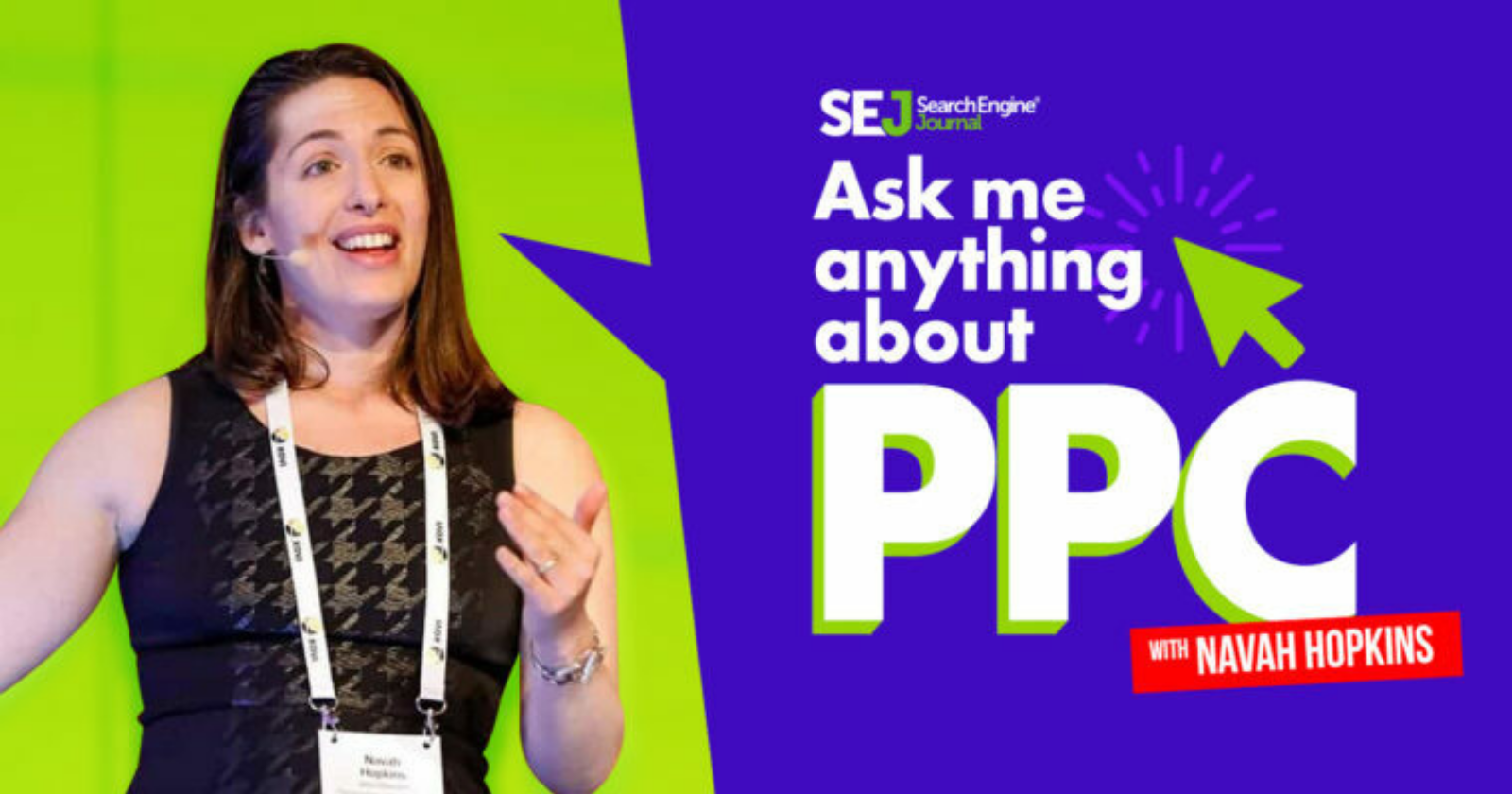We often describe digital marketing as equal parts art and science.
Ads can be a wonderful conduit for creativity. But they can also be infuriating to come up with or experience (if bad).
In this installment of Ask a PPC, we dive into the question:
“What makes a good ad? Sometimes when I try to get creative, I get hit with eligibility or Quality Score issues.”
This post will be mostly focused on text ads (given the question) but we’ll touch on display, social, and video, as well. Let’s take a look at the mechanics of good ads and creative audits.
Mechanics of Good Ads
Before diving into text/display/social/video-specific mechanics, let’s begin with a general overview of what a good ad does and does not have.
Great ads:
- Tell the prospect to do something.
- Engage the prospect based on where they are in the customer journey.
- Regardless of channel, seamlessly translate brand value and identity.
The last bullet point is often a sticking point for folks who are used to creating ads for one channel but might not have the confidence to test creative for others.
Average ads, on the other hand:
- Rigidly adhere to formulas.
- Focus on the brand instead of the prospect.
- Include content in all spots.
It’s worth noting that your ads can do passably without calls to action (if you can get volume behind them). However, you can’t expect amazing performance from ads that don’t ask viewers to complete an action.
And bad ads:
- Break the rules and get disapproved.
- Ignore what personalization options we have available.
- Don’t ask the user to do anything.
Text Ads
During Google Marketing Live, Google confirmed Responsive Search Ads (RSAs) are the default in new accounts. This doesn’t mean expanded text ads are going away, but it does mean the strategies we employ need to fit both ad formats.
RSAs are made up of:
- Minimum of three headlines (30 character limit each), maximum of 15.
- Two descriptions (90 character limit each), maximum of four.
- One path set (two 15-character addendums to your root domain).
- Optional tracking templates.
Only the first two headlines are guaranteed to show in a text ad, so it’s important to pin your calls to action in either headline one or two.
Providing this input will speed up the algorithm learning period while protecting your brand from faux pas like this:

Be sure each headline can stand on its own while being related to the others.
The more creative you include, the better.
Even if it doesn’t serve on the SERP, giving ad platforms the option improves CTR.
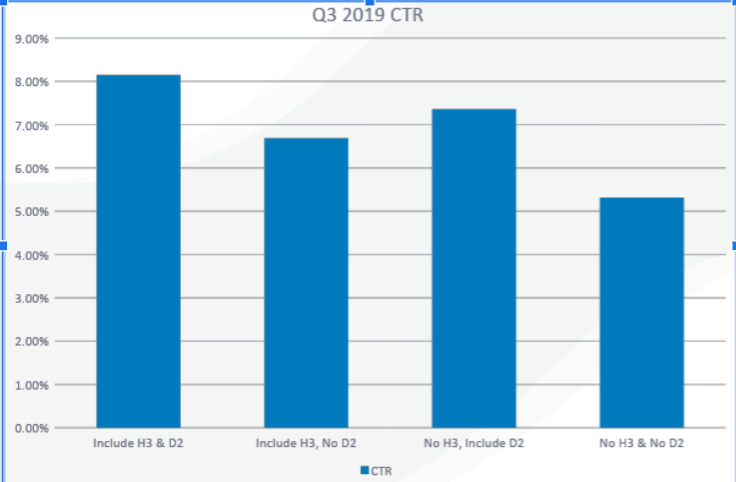 Based on 51K ads with at least one click.
Based on 51K ads with at least one click.As the graph shows, including the second description was more important to CTR than the additional headline but including all options performed the best.
Paths tend to make the best homes for keyword relevancy. Ads that keyword stuff (including a keyword 2+ times) tend to see lower CTR.
Display Ads
Many mistakenly assume that display can only be useful for remarketing.
A great display ad can:
- Prequalify prospects by equipping them with your minimum customer criteria.
- Blitz the market and build awareness and potential leads/sales at discount.
Building display ads means including creative for all the potential spots (sizes here), or sacrificing some creative polish to use responsive display ads.
If you opt for a responsive display ad (RDA), you’re intentionally sacrificing some level of brand control in the name of reach. These ads will open all possible placements to you.
They require:
- At least three images/videos (including a logo), and can have up to 15 assets.
- One long headline.
- At least one regular headline, up to five.
- At least one description, up to five.
- Business name.
- Final URL.
These ads, while not perfect, tend to outperform traditional ads simply because they have more access to spots.
Additionally, they allow you to pull in creative from your site, social profiles, and stock images.
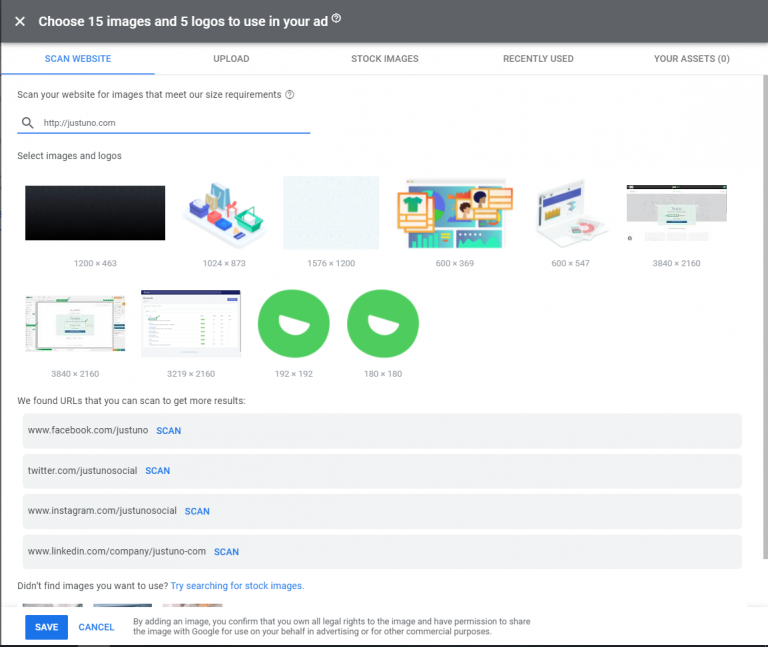
If you use videos as assets, be sure they’re no longer than 15 seconds.
Build a button into your creative if you want the user to click. While RDAs will have a CTA button, purely human creative requires that design be factored in.
Social display ads (ads in the feed) have the following components:
- Headline: Flavor text for the call to action.
- Primary Text: This should be treated as what you’d preface a social share with.
- Description: If room allows, additional information shared on desktop spots.
It’s important to note that social ads often have written elements truncated, so it’s better to write something succinct and engaging.
Call to action buttons are optional and can lead to a site, call, app download, lead form, or event.
Ads focused on leads and sales should leverage the pre-built CTAs (there’s a case for all but “click link”).
Given that social channels need new creative often (ideally swapping out every 2-3 weeks), it’s okay if you need to use stock images.
Just be sure that your written text frames the visuals well and choose an image that points to the CTA.
Video Ads
YouTube Ads will fall into these categories:
- Bumper: 6-second spots serving before or after the main video.
- In-stream non-skippable: 15-second spots that serve before/during/after the main video.
- In-stream skippable: 30+ second spots serving before/during/after the main video that can be skipped after five seconds.
- Outstream: Video spots serving in spots other than main YouTube.
These ads will have (depending on format):
- Video: If you selected a time-specific format, you’ll be warned if your video is incompatible with it. Note: You will need to have already uploaded the video content as a YouTube video.
- CTA: 10 characters (“Learn more” is a hero here).
- Headline: 15 characters to position your CTA.
- Final URL: Where your clickable element will lead.
- Display URL: What the user sees (I advise just using the root domain).
- Companion Banner: Either the logo for your channel or an uploaded image.
The most important thing to remember about YouTube is understanding at the outset what you want your audience to do. If the goal is to drive sales, don’t waste time with a bumper ad on brand awareness (go straight for shopping with TrueView).
Given that you’ll only pay for skippable ads if the user makes it to the 15-second mark in a 30-second spot/30-second mark in a 60+ second spot, many advertisers will focus on getting the most important info (brand, offer, means to contact) across in the first 5-10 seconds.
While this is important, it’s just as valuable to use creative that inspires the user to watch the full message.
If your goal is to drive users to a landing page, make sure they watch long enough to get the link.
Social videos are less oriented around time and more focused on objectives. They have the same elements as social display ads; the main difference is the creative.
Where YouTube thrives on sound and high-impact early engagement, social ads depend on user accessibility.
Social ads should be able to communicate their message without sound and own the difference between channels.
See 8 Tips for More Effective Video Ads to learn more.
Creative Audit
We’ve covered the core mechanics of each ad copy creative type. Now let’s dive into winning creative!
Text Ad
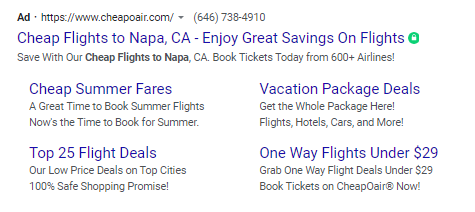
This ad does the following really well:
- Leveraging enhanced site links so it can take up the most amount of space.
- Owning the discount-obsessed consumer.
- Linking a positive emotion to booking with them (joy).
- Chaining the want/need with an easy-to-understand call to action.
This ad falls a little short in these areas:
- It clings to “cheap” a little too closely. The ad would be better served by peppering in a few synonyms.
- Lack of addressing the prospect, with too much focus on themselves (“our” vs “your).
- Limited extensions beyond site links and call extension, meaning missed opportunities to communicate additional value.
I would rate this as an average ad. It will get the job done, but could have been written by a machine. Solid B-grade ad.
Display Ad
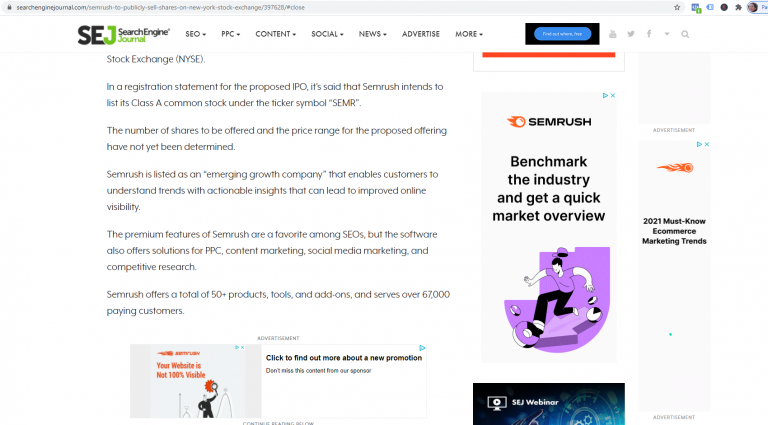
Where display ads are served is just as important as the creative itself. It’s a masterclass in brand ownership to “own” the story talking about your brand with display ads surrounding it.
What the ads do well:
- Offer value to the user without forcing a sale.
- Ad design captures the user’s attention and directs them to important CTA.
- Bolsters the impact of the news coverage.
These ads fall a tad short in these areas:
- Brand inconsistency stemming from the “rebrand,” which means old and current assets are being used.
- While the correctly branded ad does a great job, the RDA below the article doesn’t make sense. Had it fleshed out the long headline/description a bit more, it likely would have worked well.
- The assets used for the RDA spots leave too much negative space, making them look amateurish.
These ads are good, and what keeps them from greatness is branding consistency/human errors. Overall, I’d go with a B+/A- because of the halo impact they have on the page they’re on.
Facebook Ad
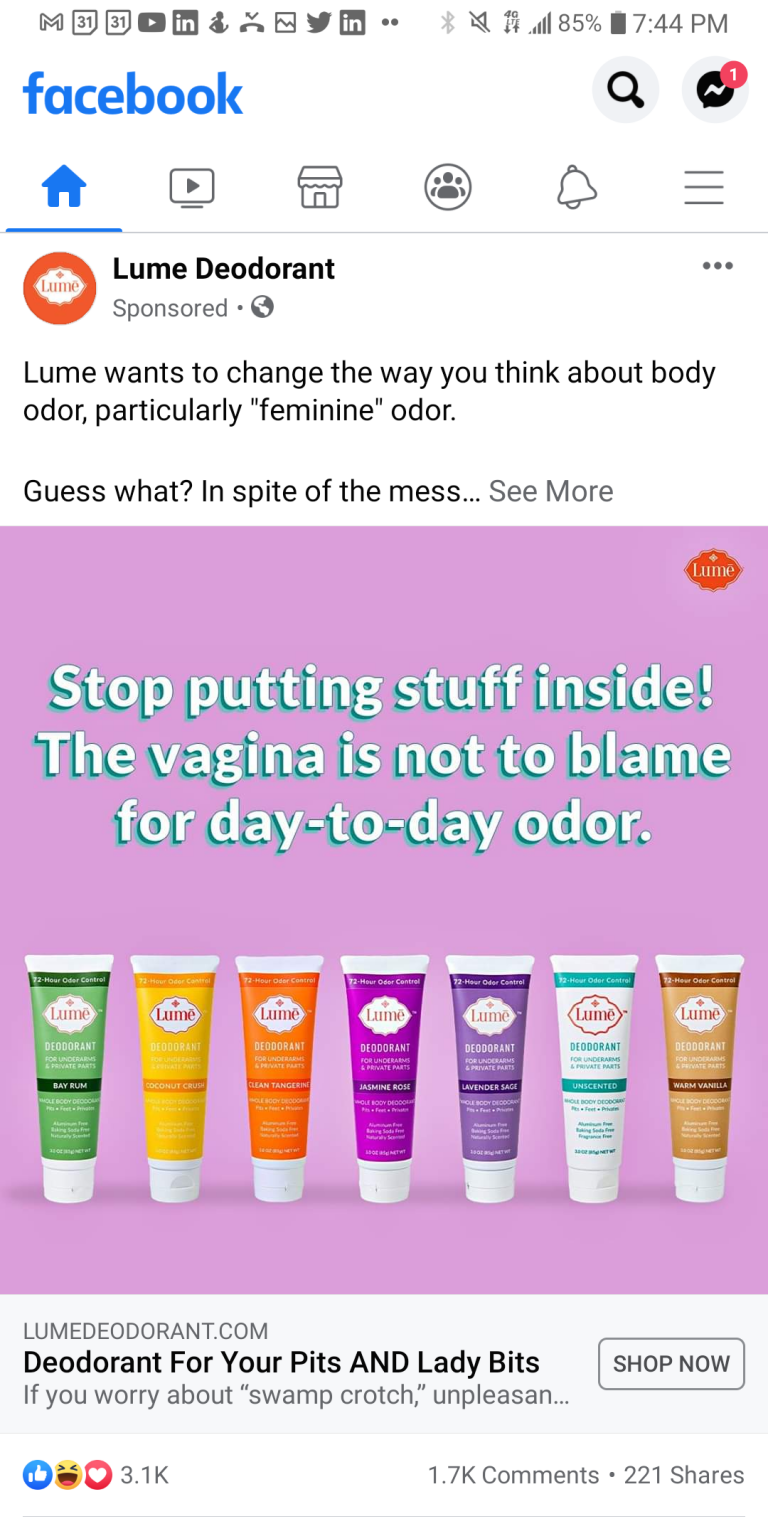
This is a magical ad for many reasons:
- Product and personality on full display!
- The targeting is on point, speaking to a pain point that buyers might experience and can use them to solve.
- Great balance of written and visual content, which allows the CTA to shine.
Only a few minor tweaks to be considered:
- Some might see the language/product usage as lewd, which might deter some from engaging (a worthy risk, in my opinion).
- The ad highlights many flavors, instead of formats. They might get better engagement showing they’re more than the lotion application.
Overall – solid A+ from me!
YouTube Ad
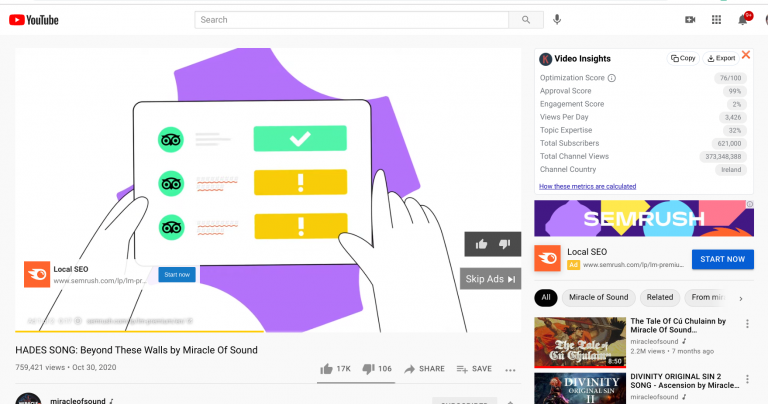
Semrush’s video ad does a great job in a lot of ways:
- Covers the “who,” “what,” and “why” in the first six seconds of the ad.
- Product/persona-specific ads and landing pages make engaging easy.
- Takes a complex topic (local SEO) and makes it intentionally accessible.
This ad could be improved by:
- Better frequency capping. As good as this ad is, it gets a little old by the 20th time you’ve seen it.
- The voice feels robotic, which can put the user off.
Overall, it’s a B+ ad that does a great job of communicating value and leverages the format.
Takeaway
Great ads are the result of clever creative, honoring channel needs, and speaking to prospects as humans.
Have a question about PPC? Submit via this form or tweet me @navahf with the #AskPPC tag. See you next month!
More Resources:

